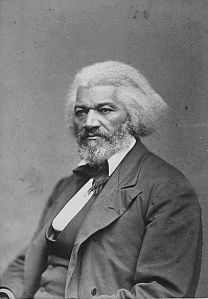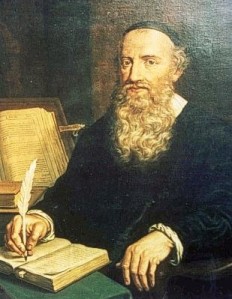Garrison and Douglass: Friendship and Estrangement
 The most famous white abolitionist in the U.S., and deservedly so, is
The most famous white abolitionist in the U.S., and deservedly so, is  William Lloyd Garrison. The most famous black abolitionist, and deservedly so, is Frederick Douglass. For over a decade (1841-1850), they were also close friends and co-workers in the American Anti-Slavery Society. While not identical, their views on most topics of the day were close and each defended the other from attacks by critics. Yet their friendship ended and the two men became estranged–a breach that was never healed in life. Why?
William Lloyd Garrison. The most famous black abolitionist, and deservedly so, is Frederick Douglass. For over a decade (1841-1850), they were also close friends and co-workers in the American Anti-Slavery Society. While not identical, their views on most topics of the day were close and each defended the other from attacks by critics. Yet their friendship ended and the two men became estranged–a breach that was never healed in life. Why?
Was it lingering racism on Garrison’s part, or an unconscious patronism that had difficulty when Douglass’ fame and leadership began to outstrip Garrison’s in the cause they both lived for? Was it simply natural competition and resentment between two selve-made men from humble backgrounds–both strong-willed, ambitious, strivers? Was it a growing “black nationalism” on Douglass’ part–an estrangement from the goal of an equal and integrated society? Did the complex tensions of self-determination and integration break the two men apart in a way similar to the break-down of “black and white together, we shall overcome” in the face of militant nationalism and smoldering resentments in the Freedom Movement a century later? Can we who seek a just and equal “rainbow society” today learn from both their friendship and its breakdown?
First, let us examine their very real friendship. William Lloyd Garrison (1805-1879) was older than Frederick Douglass (c.1818-1895) by more than a decade and began as a mentor to Douglass. They met in an 1841 meeting of the American Anti-Slavery Society in which Garrison was the headline speaker but Douglass was unexpectedly asked to tell the story of his life during slavery and his escape to freedom. (Even his name, Frederick Douglass, was a pseudonymn to make it harder for slavecatchers to find and return him to slavery.) Riveted like everyone else, Garrison asked the crowd, “Have we been listening to the testimony of a piece of property or a man?” “A man!” they thundered in reply. “Can we ever allow such a man to be treated as property?” “Never!” “Can you doubt that such treatment is the grossest sin?” “No!” “Then will you pledge with us to end this sin and crime in which 3 million of our fellow beings are not seen as fellow citizens, but simply as property and tools of another to use as he will?” “YES!!”
Garrison and Douglass often shared a speaking stage for the American Anti-Slavery Society and they worked well together. Because Garrison’s religious views had become more suspect (from hanging around Hicksite Quakers, Unitarians and holiness perfectionists) and Douglass was seen as more theologically orthodox, the tag-team often had Garrison keep quiet on-stage about the churches’ complicity in slavery while Douglass would thunder against the racism of the white churches. Meanwhile, because Douglass was more vulnerable to reprisals by local, state, and federal governments, it would be Garrison who took the lead in criticizing the racism even of the free states. This was a careful strategy since both men actually had radical views about the need for reform of both state and church.
Both were also strong supporters of women’s rights–although, after Garrison’s death, Douglass would strain his relationships with many white feminists by supporting the passage of the 15th Amendment to the U.S. Constitution even though it protected the voting rights of black men but continued to deny the right to vote to women of all races.
Garrison’s paper, The Liberator, first published Douglass’ story in 1845 as Narrative of the Life of Frederick Douglass, an American Slave. Garrison has never received enough credit for this publication. It was a bestseller and most of the profits went to Douglass and to the abolitionist movement–Garrison was poor throughout his life and made no attempt to exploit Douglass’ story for his personal gain. He also took quite a risk in publishing Douglass’ book and was charged with several crimes, but he faced the charges bravely. Moreover, he recognized that this publication placed Douglass in grave danger of being recognized and reclaimed by his former “masters.” Garrison solicited wealthy abolitionists for funds to enable Douglass to tour Britain on the lecture circuit in order to avoid capture. Further, although Garrison was against schemes of ending slavery by paying off slaveholders (enabling them to profit from their sin of slaveholding) instead of compensating slaves for their free labor, he defended the morality of escaped slaves and free blacks purchasing their own or others’ freedom. Just as in cases of kidnapping and ranson, Garrison argued, the sin is not in paying for freedom, but with those who receive such money for the crime the King James’ Bible called “man-stealing.” Thus, against further criticisim, when he joined Douglass in England at the end of the lecture tour, Garrison helped him raise money and purchase his freedom so that he could return to America without risk of arrest under the Fugitive Slave Law.
The split between the two men began in 1848 when Douglass started his own newspaper, The Northstar instead of continuing as a lecturer for the AAS and a regular writer for The Liberator. This cannot be seen as a racist attack on black-owned business by Garrison. He had long been a supporter of black entrepeneurs. He had even previously supported a black-owned abolitionist paper in New York (The Ram’s Horn). But, while The Liberator had once had a virtual monopoly on abolitionist papers, there was now much competition and Garrison had to see The North Star as an economic rival, especially for black subscribers. Black subscribers had kept the always-poor Garrison afloat during many hard times. Now that abolitionism was a much bigger movement, there was competition for subscriptions and The North Star’s success might come at The Liberator’s expense–or so it had to appear to Garrison.
The split continued when Douglass changed his mind over political activity. He had started in complete agreement with Garrison that the Constitution so protected slavery that the legal overthrow of slavery would need “disunion” and a new Constitution. But after founding The North Star, Douglass came to agree with members of the short-lived Liberty Party that the Framers had intended the Constitutional compromises with slavery to be short-lived, that slavery was un-Constitutional, and that Congress had the power to end slavery. He was thus a supporter of the new Republican Party (a “free soil” party) while Garrison continued to see party politics as a distraction from the work of abolishing slavery having it seen as morally abhorrent by the overwhelming majority so that the popular will would demand a new (anti-slavery) Constitution.
The split widened when Douglass rejected his earlier pacifism to praise John Brown’s raid on Harper’s Ferry. Garrison saw Brown as being more morally right than the defenders of slavery–and struggled to show non-pacifists that Brown should be seen in the same light as the American patriots who rebelled against Britain. But he continued to see nonviolence as a more excellent way, still. But Garrison also, reluctantly supported the Civil War (and saw one of his own sons enlist on the Union side) and black soldiers after Lincoln signed the Emancipation Proclamation. But while Garrison abandoned his absolute pacifism reluctantly and returned to the struggle for a peaceful world that would outlaw war after the end of the Civil War, Douglass moved to support the concept of “defensive” wars. And Douglass ended up being influential with Abraham Lincoln in a way that Garrison never was. The differences caused resentments.
But was this racism on Garrison’s part? Perhaps. I am among those who believe that in a thoroughly racist society like ours, it is impossible to be completely without racial prejudices. The best we can do is to try constantly to become aware of our lingering prejudices, confront them, and attempt a life as a “recovering racist.” I don’t think Garrison would have disagreed. He worked his entire life to see where he fell short of holiness, repent, and become more sanctified. But I also think that some kind of split might have happened even if both men were the same color–because when students surpass mentors in fame and influence it usually creates generational rifts even if the mentor is rightly proud of the student’s success.
It is also difficult in our competitive society for two men to work so closely together, share so much, and maintain a close friendship. The failure in Garrison and Douglass’ case is a case study in the tragedy of so many men to be able to sustain close friendships over a lifetime, but we ought also to give praise to the way they were able to sustain such a friendship for over a decade in very trying circumstances. Outside of military service during war, we have few examples of such close friendships among heterosexual males for any length of time. Garrison and Douglass both worked for a society that would go beyond the patriarchy that works against close male friendships, so it is sad that they did not succeed with each other–friendships should be able to survive differences inviewpoints when two kindred spirits agree on so much of the “big picture.”
Douglass was probably the deeper thinker–and it is good to see today a renewed interest in Douglass by political scientists, moral philosophers, and theologians. But Garrison deserves more credit in all those areas than he usually gets, too–and without Garrison, would we have ever known Douglass at all?

Thanks for this; last night I just finished the chapter on Douglass’ in J. Kameron Carter’s Race, so happy timing there. I also appreciate and agree with the notion of all of us (at least white folks) being forever “recovering racists.” The prejudice always buries its head in some deeper cavern in need of being rooted out.
Kameron’s book is great and part of the renewed interest in Douglass I mentioned. It’s also the most thorough theological investigation on race done yet.
A great lesson in history – instructive for our own day as we continue to struggle with issues of justice and equality while suffering the scars of a competitive and patriarchal society.
Without trying to psychoanalyze Douglass or Garrison, Westmoreland-White succeeds remarkably in effectively addressing human nature in general. Throughout American history, actually world history, great allies have become estranged if not antagonistic. And that has set back many causes for years, decades, or forever. What’s the solution? It’s humility and compromise. But, sadly, that’s not human nature. And it never will be. Therefore, let’s just actively support both the Douglases and the Garrisons of the world, present and future.